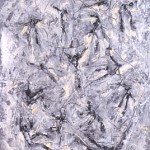‘Information Paintings,’ an exhibit by James Gilroy also featuring “Don’t Let Go”, a digital documentary with James Gilroy & Larry Clark directed by Neil Grayson
and edited by Chris Schwerin.
Art is born at “the edge of order and chaos,” to borrow Christopher Langton’s phrase, where novel patterns are related to their predecessors, emerging from while transforming convention. According to Langton, who is a central figure in the field of evolution theory, life is only possible within a special equilibrium of order and disorder. The same is easily said for the evolution of art. Science has recently done much to inform the arts. Specialists in the phenomenon of self-organization–who would include Langton as well as Margaret Boden, Murray Gell-Mann, Stuart Kaufman, and lIya Prigogine–have increased popular understanding of how, overtime, order inevitably emerges out of disorderly chance events.
James Gilroy’s Information Paintings, on exhibition at Dactyl Foundation through December 10th, are a visualization of the concept of life and art as described by Langton. Gilroy’s last exhibition at Dactyl in spring of 1997 featured rich, but well-defined single figures and selected pairs. Gilroy expanded his field of vision to execute the new collection, which features medium-sized oilstick sketches and larger oil paintings of “soupy” mixes of figures, interacting, swimming together and forming abstract collectives. The “Information Paintings” tend more toward chaos than the earlier work. Each little figure in these multiple-figure paintings opens itself up to all sorts of influences from its environment. Thus, each one is more a part of its surroundings than it is an individual unique self. From a distance, the multiple figures seem to form a significant design, which Gilroy claims he does not consciously plan but which emerges on its own. It seems much like the self-organization that arises in the phenomenon of flocking. Though there is no one member acting as choreographer, each individual is in such close communication with its neighbor that an overall organization emerges through the generalized collectivity of the group. Part of the thrill and challenge of appreciating this new work comes when one approaches the paintings and looks carefully at the individual figures apart from the whole. It is then that one can see that each figure does actually have its own personality and a uniqueness that is both suppressed by the collective identity and responsible for it.

In “Don’t Let Go,” a documentary produced by Dactyl Foundation and directed by Dactyl visual art director Neil Grayson, Gilroy and his long-time friend, photography filmmaker Larry Clark, explore the issue of artistic control. About his own approach, Gilroy explains: “The ‘Information Paintings’ represent the equation of the single. figure, just extended, extended, extended. I related almost uncomfortably to that single figure. It’s like my emotional statement. . . It’s me. . . And these others: Me and the world. There’s so much information. You try and make sense, but it’s soup; everything connects. It’s gumbo. Out on the street of New York, you’re in defense mode. You cannot be extended or connected with the world–you’d get mushed. You have to hold yourself in. I have to maintain some kind. of control. . . Each little figure I do, I have to be emotionally and intellectually present to represent it. If I don’t think about what I’m doing, they lose form; there isn’t a rhythm; they don’t match up; they start to swell out or shrink down; they become a mess. And even though I don’t look at the overall patterning of them, it does become this thing–it makes this other much larger statement. ”
The “Information Paintings” are cool and abstract. They have the kind of non-intentional beauty that one finds in nature. Gilroy’s more emotional statement, his quintessentially human statement, is made by the two singular paintings in the collection: Epiphany and The Little Prince. Though they each feature but one figure, they seem to contain all the information of the chaotic “Information Paintings” only translated, filtered and matured by the artist’s peculiar and potent vision.
Victoria N. Alexander

